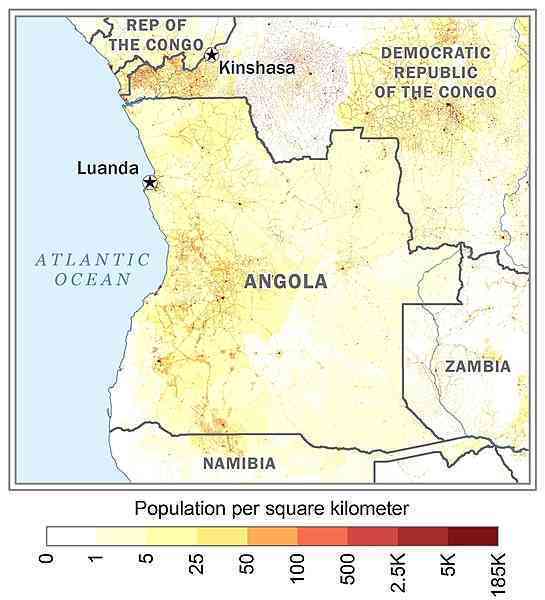
Southern Africa, bordering the South Atlantic Ocean, between Namibia and Democratic Republic of the Congo
12 30 S, 18 30 E
Africa
total: 1,246,700 sq km
land: 1,246,700 sq km
water: 0 sq km
about eight times the size of Georgia; slightly less than twice the size of Texas
total: 5,369 km
border countries (4): Democratic Republic of the Congo 2,646 km (of which 225 km is the boundary of discontiguous Cabinda Province); Republic of the Congo 231 km; Namibia 1,427 km; Zambia 1,065 km
1,600 km
territorial sea: 12 nm
contiguous zone: 24 nm
exclusive economic zone: 200 nm
semiarid in south and along coast to Luanda; north has cool, dry season (May to October) and hot, rainy season (November to April)
narrow coastal plain rises abruptly to vast interior plateau
highest point: Moca 2,620 m
lowest point: Atlantic Ocean 0 m
mean elevation: 1,112 m
petroleum, diamonds, iron ore, phosphates, copper, feldspar, gold, bauxite, uranium
agricultural land: 45.7% (2018 est.)
arable land: 3.9% (2018 est.)
permanent crops: 0.3% (2018 est.)
permanent pasture: 41.5% (2018 est.)
forest: 54.3% (2018 est.)
860 sq km (2014)
Rio Zambeze (Zambezi) (shared with Zambia [s], Namibia, Botswana, Zimbabwe, and Mozambique [m]) - 2,740 km; Rio Cubango (Okavango) river source (shared with Namibia and Botswana [m]) - 1,600 km
note – [s] after country name indicates river source; [m] after country name indicates river mouth
Atlantic Ocean drainage: Congo (3,730,881 sq km)
Indian Ocean drainage: Zambezi (1,332,412 sq km)
Internal (endorheic basin) drainage: Okavango Basin (863,866 sq km)
Congo Basin, Upper Kalahari-Cuvelai-Upper Zambezi Basin
most people live in the western half of the country; urban areas account for the highest concentrations of people, particularly the capital of Luanda as shown in this 
locally heavy rainfall causes periodic flooding on the plateau
the province of Cabinda is an exclave, separated from the rest of the country by the Democratic Republic of the Congo
NOTE: The information regarding Angola on this page is re-published from the 2024 World Fact Book of the United States Central Intelligence Agency and other sources. No claims are made regarding the accuracy of Angola 2024 information contained here. All suggestions for corrections of any errors about Angola 2024 should be addressed to the CIA or the source cited on each page.
This page was last modified 04 May 24, Copyright © 2024 ITA all rights reserved.